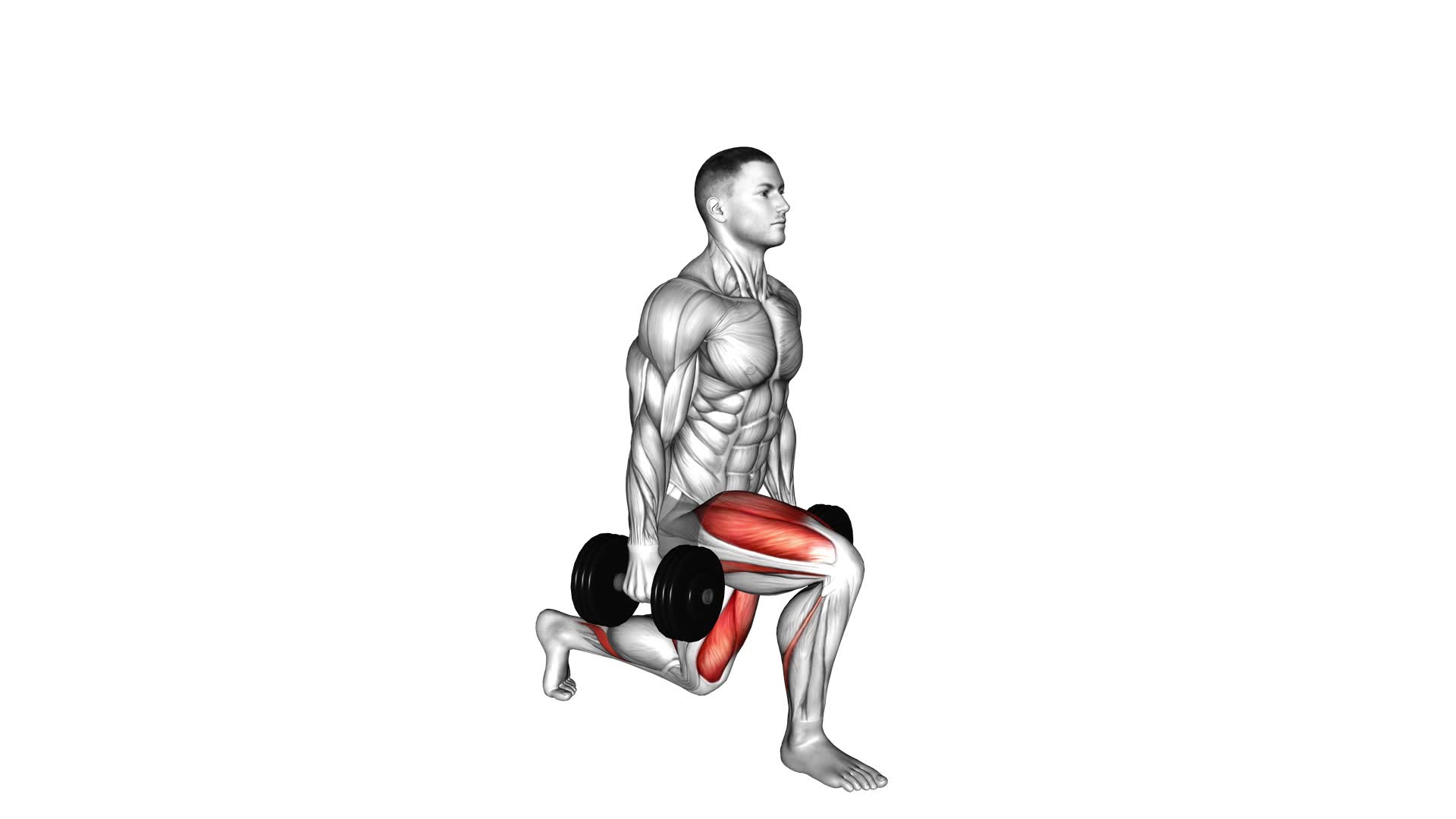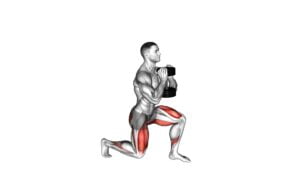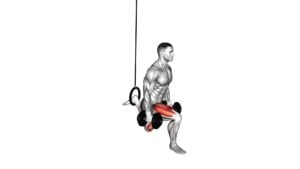Dumbbell Split Squat – Video Exercise Guide & Tips

Are you looking for a challenging lower body exercise that targets your quads, glutes, and hamstrings? Look no further than the dumbbell split squat!
Watch This Exercise Video
In this video exercise guide, you'll learn the proper form and technique, as well as variations to add intensity to your workout.
Avoid common mistakes and get tips for a more effective routine. Get ready to strengthen and tone your legs with this powerful exercise.
Let's dive in!
Key Takeaways
- The Dumbbell Split Squat targets quads, glutes, and hamstrings.
- Variations and modifications can be used to increase intensity, such as using a weighted vest or resistance bands.
- Injury prevention and proper form are important, including warm-up, stretching, and maintaining a stable core.
- The Dumbbell Split Squat improves lower body strength, stability, and balance, while increasing flexibility and engaging the core.
Benefits of the Dumbbell Split Squat
To maximize your workout and strengthen your lower body, incorporating the dumbbell split squat can provide significant benefits. This exercise targets multiple muscle groups, including the quadriceps, hamstrings, glutes, and calves. By adding dumbbells to the split squat, you increase the resistance and further challenge your muscles, leading to greater strength gains.
One of the advantages of the dumbbell split squat is its versatility. There are various variations you can incorporate to target different muscles and add variety to your routine. For example, you can perform the Bulgarian split squat, where your rear foot is elevated on a bench or step, or the walking split squat, where you take steps while performing the exercise.
Improving stability is crucial when performing the dumbbell split squat. To enhance stability, keep your core engaged and maintain a neutral spine throughout the movement. Additionally, focus on keeping your front knee in line with your toes and avoid letting it collapse inward.
Proper Form and Technique
To perform the dumbbell split squat with proper form and technique, focus on maintaining a stable and balanced position throughout the exercise. This will help you improve your balance and target your glutes effectively.
Start by standing with your feet hip-width apart and holding a dumbbell in each hand. Take a step forward with your right foot, keeping your torso upright and your core engaged.
Lower your body by bending both knees until your left knee is just above the ground. Make sure to keep your front knee aligned with your ankle and avoid letting it go past your toes.
Push through your right heel to return to the starting position. Repeat on the other side by stepping forward with your left foot.
Remember to keep your movements controlled and avoid any jerking or swinging. By maintaining proper form and technique, you'll maximize the benefits of the dumbbell split squat and minimize the risk of injury.
Variations to Add Intensity
To add intensity to your dumbbell split squat, there are several variations you can try.
One option is to use a weighted vest, which will increase the resistance and challenge your muscles even more.
Another option is to incorporate resistance bands into your workout, either by attaching them to your dumbbells or using them on their own.
Lastly, you can elevate your front foot on a platform or step, which will further engage your muscles and increase the difficulty of the exercise.
Weighted Vest Options
You can enhance the intensity of your dumbbell split squats by incorporating various weighted vest options.
Adding a weighted vest to your workout routine offers several benefits. First, it increases the resistance, challenging your muscles and making the exercise more effective. This can lead to greater strength gains and muscle development.
Second, wearing a weighted vest can help improve your cardiovascular fitness by increasing the demands on your heart and lungs.
Lastly, it can enhance your overall calorie burn, helping you to achieve your weight loss goals.
When choosing a weighted vest, consider the weight increments available and the adjustability of the vest to ensure a comfortable and secure fit. Start with a lighter weight and gradually increase as you become more comfortable and confident.
Resistance Band Modifications
To add intensity to your dumbbell split squats, consider incorporating resistance band modifications.
Resistance bands are a versatile tool that can help you take your split squats to the next level. One way to do this is by using a resistance band around your upper thighs during the exercise. This will create additional resistance and engage your glutes and outer thighs even more.
Another advanced modification is to use the resistance band to perform banded split squats. Place the band around your front foot and hold onto the ends with your hands. As you lower into the squat, the band will provide resistance, challenging your muscles even further.
These resistance band modifications will help you increase the intensity of your dumbbell split squats and take your leg workout to new heights.
Elevated Platform Variations
Adding an elevated platform to your dumbbell split squats can increase the intensity of the exercise. By raising the platform height, you challenge your lower body muscles even more and engage your core for better stability. Here are three variations utilizing an elevated platform that will take your split squats to the next level:
- High Step Split Squats: Place one foot on a high step or platform, keeping your back foot elevated. Lower your body down into a lunge position, then push through your front heel to return to the starting position.
- Single-Leg Bulgarian Split Squats: Stand facing away from a bench or platform, with the top of your back foot resting on it. Lower your body down into a lunge position, then drive through your front heel to come back up.
- Elevated Plyometric Split Squats: Perform a regular split squat with one foot on an elevated platform. As you come back up, explode off the ground and switch legs mid-air, landing in a split squat position with the opposite foot on the platform.
Incorporating these elevated platform variations not only adds intensity to your workouts but also enhances your balance training.
Now, let's move on to the next section and discuss common mistakes to avoid.
Common Mistakes to Avoid
To ensure you perform the dumbbell split squat correctly and avoid common mistakes, it's important to focus on proper form demonstration. This will help you maintain balance and stability throughout the exercise, reducing the risk of injury.
Additionally, incorporating injury prevention tips, such as engaging your core and keeping your knee in line with your toes, will further enhance your safety and effectiveness while performing this exercise.
Proper Form Demonstration
Avoid these 3 common mistakes when performing the dumbbell split squat to ensure proper form and maximize results:
- Leaning too far forward: Keep your torso upright and engage your core to maintain balance and prevent strain on your lower back.
- Not stepping far enough back: Take a big enough step backward so that when you lower your body, your front knee stays directly above your ankle. This helps target the glutes more effectively.
- Neglecting the back leg: Remember to engage the muscles in your back leg as well. Push through the heel of your back foot to activate your glutes and hamstrings.
Injury Prevention Tips
To prevent injuries and maximize your results, focus on proper form and technique when performing the dumbbell split squat exercise.
Before starting your workout, it's important to warm up your muscles and prepare them for the exercise. Incorporate warm-up exercises like jumping jacks or jogging in place for a few minutes to increase blood flow and raise your body temperature. Additionally, stretching techniques, such as lunges and leg swings, can help improve flexibility and reduce the risk of muscle strain.
Remember to maintain a stable core, keep your front knee aligned with your ankle, and avoid leaning forward or backward during the exercise.
By following these injury prevention tips, you can ensure a safe and effective dumbbell split squat workout.
In the next section, we'll provide you with tips for a more effective workout.
Tips for a More Effective Workout
Maximize your workout effectiveness with these key tips:
- Focus on improving balance: Incorporate exercises that challenge your balance, such as the dumbbell split squat. This not only helps to build strength in your legs and glutes, but also improves your overall stability and coordination. By working on your balance, you can enhance your performance in other exercises and reduce the risk of injuries.
- Target specific muscles: To get the most out of your workout, it's important to target specific muscles. The dumbbell split squat primarily targets your quads, glutes, and hamstrings. By focusing on these muscles, you can effectively build strength and tone your lower body. To further enhance muscle targeting, adjust the weight of the dumbbells to a level that allows you to perform the exercise with proper form and feel the burn in the targeted muscles.
- Maintain proper form: Proper form is crucial for an effective workout. It ensures that you're targeting the right muscles and reduces the risk of injury. When performing the dumbbell split squat, keep your chest up, shoulders back, and core engaged. Step forward with one foot and lower your back knee towards the ground, making sure your front knee doesn't go past your toes. Push through your front heel to return to the starting position. By maintaining proper form, you can maximize the benefits of this exercise.
Sample Dumbbell Split Squat Workout Routine
To start a sample dumbbell split squat workout routine, begin by selecting an appropriate weight dumbbell for your fitness level. The dumbbell split squat is a challenging exercise that targets multiple muscle groups, including the quadriceps, glutes, and hamstrings. It also engages your core for stability and balance.
When performing the dumbbell split squat, it's important to maintain proper form. Keep your chest up, shoulders back, and engage your core. Take a large step forward with one foot and lower your body until your front thigh is parallel to the ground, making sure your knee doesn't extend beyond your toes. Push through your front heel to return to the starting position.
To modify the dumbbell split squat, you can use a lighter weight dumbbell or perform the exercise without any weight at all. As you become more comfortable and stronger, you can gradually increase the weight to continue challenging yourself.
Incorporating dumbbell split squats into your workout routine can provide numerous benefits. It helps improve lower body strength, stability, and balance. Additionally, it can increase flexibility and range of motion in your hips and ankles. By targeting multiple muscle groups, the dumbbell split squat is an efficient exercise for building strength and sculpting your lower body.
Frequently Asked Questions
How Many Sets and Reps Should I Aim for When Performing the Dumbbell Split Squat?
When performing the dumbbell split squat, it's important to consider the optimal weight for your fitness level. Start with a weight that challenges you but allows you to maintain proper form.
As for sets and reps, it's recommended to begin with 2-3 sets of 8-12 reps per leg. As you progress, gradually increase the weight and reps to continue challenging your muscles.
Remember to listen to your body and adjust accordingly.
Can the Dumbbell Split Squat Help With Improving Balance and Stability?
Improving balance and stability are some of the benefits of the dumbbell split squat. By incorporating this exercise into your routine, you can target and strengthen the muscles in your legs and core, which are essential for maintaining balance and stability.
The split squat also helps to improve coordination and proprioception, allowing you to move with more control and confidence. Adding dumbbells to the exercise increases the challenge and further enhances these benefits.
Is It Necessary to Use Dumbbells or Can I Perform the Split Squat Without Any Additional Weight?
You can definitely perform the split squat without any additional weight if you prefer. It isn't necessary to use dumbbells for this exercise.
However, incorporating dumbbells into your split squat can provide additional benefits. They can increase the intensity of the exercise, helping to build strength and muscle.
Additionally, using dumbbells can also improve stability and balance by challenging your core and lower body muscles.
Can the Dumbbell Split Squat Help With Building Muscle in the Lower Body?
Yes, the dumbbell split squat can definitely help with building muscle in your lower body. By using dumbbells, you're adding resistance to the exercise, which increases the intensity and stimulates muscle growth. This exercise primarily targets your quadriceps, glutes, and hamstrings, helping to strengthen and tone these muscles.
Additionally, there are variations of the split squat that you can incorporate into your routine to target different muscle groups and add variety to your workouts.
Are There Any Modifications or Alternatives for Individuals With Knee or Hip Injuries?
If you have knee or hip injuries, you might be wondering about modifications or alternatives for the dumbbell split squat. Well, there are options for you!
When it comes to knee modifications, you can try reducing the range of motion, using a support like a chair, or even replacing the exercise with other lower body exercises like glute bridges or step-ups.
As for hip modifications, you can focus on exercises that don't put too much stress on the hip joint, such as clamshells or standing hip abductions.
Remember to consult with a professional before making any changes to your workout routine.
Conclusion
In conclusion, the dumbbell split squat is a highly effective exercise for targeting the lower body muscles and improving balance and stability.
By maintaining proper form and technique, adding variations to increase intensity, and avoiding common mistakes, you can maximize the benefits of this exercise.
Remember to always listen to your body and consult with a fitness professional if needed.
Incorporating the dumbbell split squat into your workout routine can help you achieve your fitness goals.

Author
Years ago, the spark of my life’s passion ignited in my mind the moment I stepped into the local gym for the first time. The inaugural bead of perspiration, the initial endeavor, the very first surge of endorphins, and a sense of pride that washed over me post-workout marked the beginning of my deep-seated interest in strength sports, fitness, and sports nutrition. This very curiosity blossomed rapidly into a profound fascination, propelling me to earn a Master’s degree in Physical Education from the Academy of Physical Education in Krakow, followed by a Sports Manager diploma from the Jagiellonian University. My journey of growth led me to gain more specialized qualifications, such as being a certified personal trainer with a focus on sports dietetics, a lifeguard, and an instructor for wellness and corrective gymnastics. Theoretical knowledge paired seamlessly with practical experience, reinforcing my belief that the transformation of individuals under my guidance was also a reflection of my personal growth. This belief holds true even today. Each day, I strive to push the boundaries and explore new realms. These realms gently elevate me to greater heights. The unique combination of passion for my field and the continuous quest for growth fuels my drive to break new ground.







